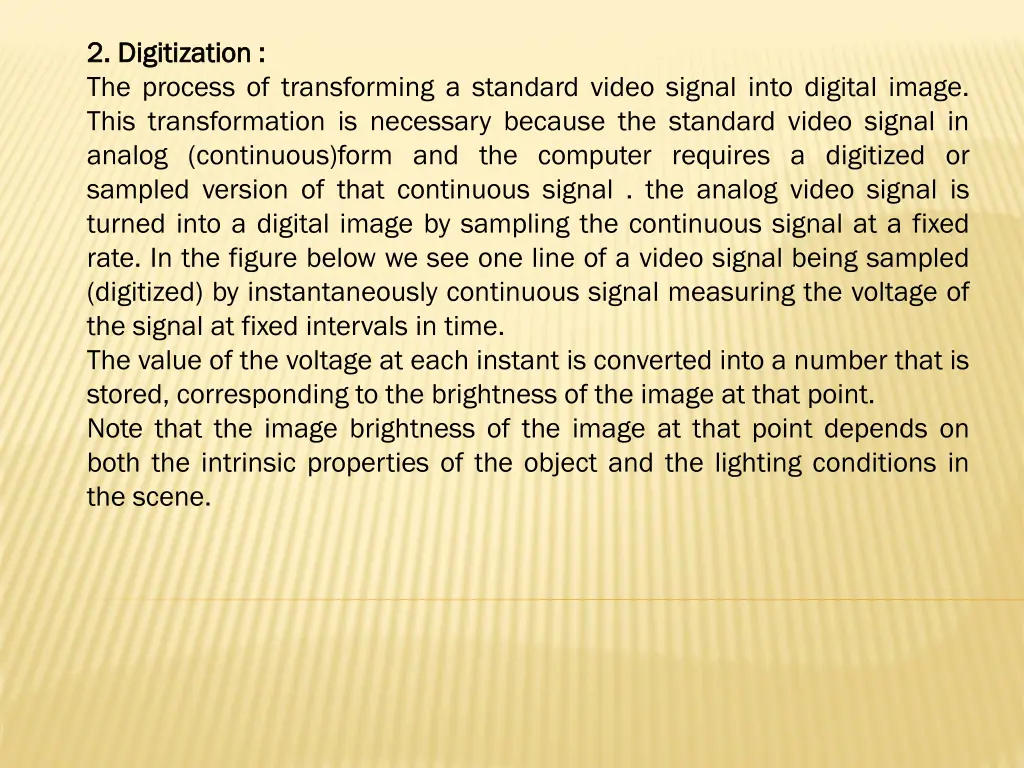
Understanding Digitization Process for Image Conversion
Explore the process of digitizing standard video signals into digital images through sampling and quantization. Learn how analog signals are transformed into digital forms suitable for computer processing, ensuring spatial and intensity accuracy for optimal image quality.
Download Presentation

Please find below an Image/Link to download the presentation.
The content on the website is provided AS IS for your information and personal use only. It may not be sold, licensed, or shared on other websites without obtaining consent from the author. If you encounter any issues during the download, it is possible that the publisher has removed the file from their server.
You are allowed to download the files provided on this website for personal or commercial use, subject to the condition that they are used lawfully. All files are the property of their respective owners.
The content on the website is provided AS IS for your information and personal use only. It may not be sold, licensed, or shared on other websites without obtaining consent from the author.
E N D
Presentation Transcript
2 2. . Digitization Digitization : : The process of transforming a standard video signal into digital image. This transformation is necessary because the standard video signal in analog (continuous)form and the computer requires a digitized or sampled version of that continuous signal . the analog video signal is turned into a digital image by sampling the continuous signal at a fixed rate. In the figure below we see one line of a video signal being sampled (digitized) by instantaneously continuous signal measuring the voltage of the signal at fixed intervals in time. The value of the voltage at each instant is converted into a number that is stored, corresponding to the brightness of the image at that point. Note that the image brightness of the image at that point depends on both the intrinsic properties of the object and the lighting conditions in the scene.
2.1. Sampling and quantization In order to become suitable for digital processing, an image function I(x,y) must be digitized both spatially and in amplitude. Typically, a frame grabber or digitizer is used to sample and quantize the analogue video signal. Hence in order to create an image which is digital, we need to convert continuous data into digital form. There are two steps in which it is done: Sampling ; related to coordinates values Quantization, : related to intensity values The sampling rate determines the spatial resolution of the digitized image, while the quantization level determines the number of grey levels in the digitized image. A magnitude of the sampled image is expressed as a digital value in image processing. The transition between continuous values of the image function and its digital equivalent is called quantization. The number of quantization levels should be high enough for human perception of fine shading details in the image. The occurrence of false contours is the main problem in image which has been quantized with insufficient brightness levels.
EXAMPLE Generating Generating a a digital Continuous Continuous scaling scaling line line from continuous continuous image, illustrate illustrate sampling sampling and and quantization sampling sampling and and quantization Digital Digital scan scan line line. . digital image image image. . from A A to to B B in in the image, used the the concepts concepts quantization. . (c) quantization. . (d) image. . (a) (b) (b) (a) A A the used to to of of (c) (d)
(a) (a) projected projected onto (b) (b) Result Result of of image and and quantization quantization. . Continuous Continuous onto a a sensor image sampling image image array. . sampling sensor array






















